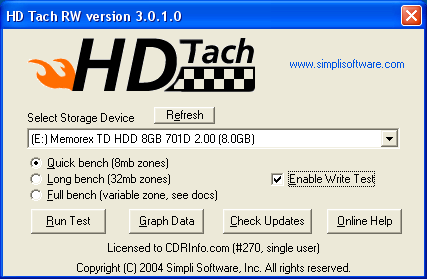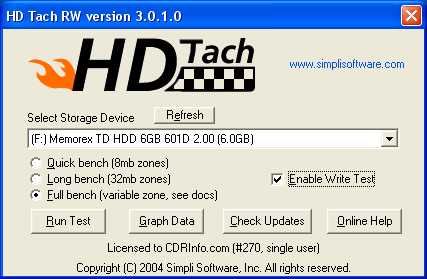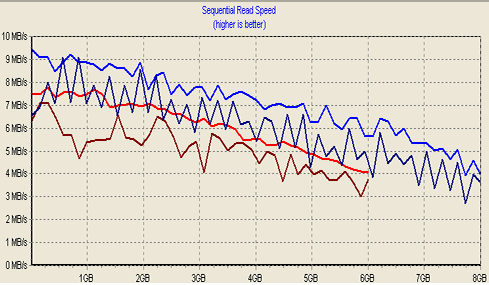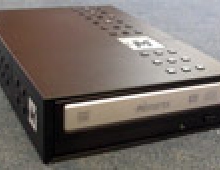Memorex Mega TravelDrive
2. Performance
We tested the performance of the Mega TravelDrive 6GB USB2.0 memory stick, using two well known benchmarking utilities, HD Tach and Sisoft Sandra 2005. All tests were made under WinXP with a USB 2.0 compatible motherboard (Abit A8N Fatal1ty series).
HD Tach Results




In the above graph, we have the reading performance in red and blue for the 6GB and 8GB devices respectively, as well as their respective writing performance in brown and dark blue. The reported performance (throughput) from HD-Tach for the Mega TravelDrive devices is not as good in comparison to other USB2.0 sticks we have tested in the past, but their larger capacity possibly accounts for this. Comparing the two devices, it seems performance is faster with the 8GB TravelDrive than with the 6GB.
Sisoft Sandra 2005 SR1 Results
Sisoft Sandra has two sets of tests.
The "File system" which tests how your drive(s) and controller(s) compare to other devices in a typical system:
· Read Test: Buffered, Random, Sequential
· Write Test: Buffered, Random, Sequential
· Seek Test
The "Drive Index" mark is a composite figure representing an overall performance rating based on the average of the read, write, and seek tests, and file and cache size. The Drive Index is intended to represent drive performance under typical use in a PC. A larger number means better performance. The weighting of the results is not equal and represents the distribution of different files sizes as used on these devices (obtained through field research).
| Device | Drive Index |
| Mega TravelDrive 6GB | 8.0 |
| Mega TravelDrive 8GB | 9.0 |
Adequate performance from both devices with the 8GB being slightly better.
The "Compact Flash" typical usage model for these devices is File operations, such as Writing a file to the device, reading a file from it, and deleting a file. This benchmark exercises the devices in terms of these operations (to measure the “raw” cluster level performance of the device, it is recommended to also test it by means of the File System Benchmark module). The following characteristics are measured for each of the four representative file sizes of 512 Bytes (representing a minimal single data cluster file), 32kB, 256kB and 2MB. The weighting of the results is not equal and it represents the distribution of different files sizes as used on these devices (obtained through field research). For each of the four file sizes, a Combined Index is then calculated, stating the combined performance in terms of Combined Operations Per Second, with respect to a mix of write, read and delete operations.
Combined Device Index: is a composite figure representing an overall performance rating based on the average of the Combined Index figures over the four file sizes. (Higher is better, i.e. better performance).
Endurance Factor: is a figure representing the Wear and Life Expectancy of flash devices; this is obtained by dividing the average performance (normal condition, i.e. sequential write) to the lowest performance (high-stress condition, i.e. same block re-write). It measures the relative improvement of endurance caused by the wear leveling or flash management algorithm; the absolute endurance of a device (i.e. its expected life-time) is directly dependent, in addition to this Endurance Factor, on the nominal manufacturer rating of maximum erase/reprogram cycles, which is typically 100,000+ for SLC and 10,000+ for MLC devices. (Higher is better, i.e. longer life-time for the device)
| Device | Combined Index | Endurance Factor |
| Mega TravelDrive 6GB | 774 | 25.8 |
| Mega TravelDrive 8GB | 2491 | 28.9 |
The most interesting thing is the reported Endurance Factor, a value which is amongst the highest we have seen for such devices. It seems that it is a result of the reduced transfer rate, read/write speed.


















